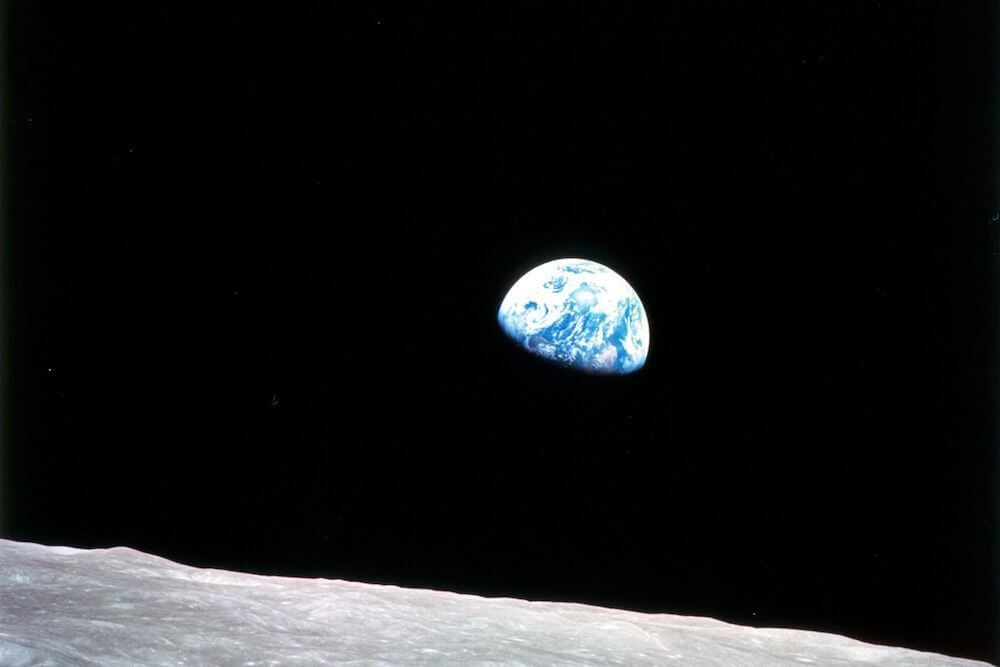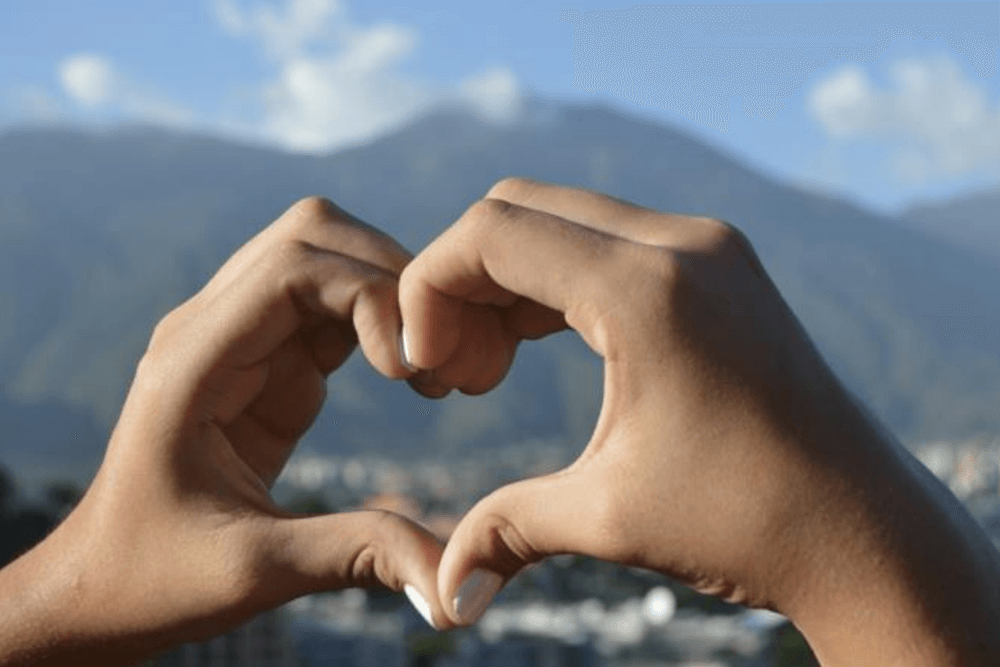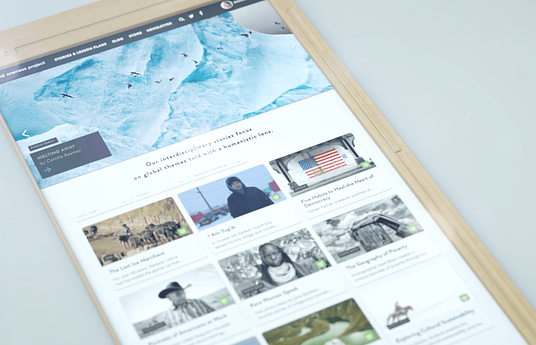HundrED partnered with Global Oneness Project to support our Youth Ambassadors to learn about the historical, cultural, and environmental influences of the iconic Earthrise photograph. After the Earthrise film and being inspired by its message, HundrED Youth Ambassadors were asked to capture their relationship and place on Earth.
Putting Earthrise in Context
On December 21, 1968, Apollo 8 launched from the Kennedy Space Center in Merritt Island, Florida. The three-man crew—Bill Anders, Frank Borman, and James Lovell—were part of an elite group of astronauts NASA had assembled to help fulfill John F. Kennedy’s goal to land a man on the moon before the end of the 1960s. Their mission was to orbit the moon, testing the viability of a future moon landing. They were the first men to leave Earth’s orbit behind, venturing 240,000 miles farther than anyone before them. During their lunar orbit, the crew emerged from the dark side of the moon to see the Earth rising before them. They quickly scrambled to capture the image. This was the first color photograph taken of the Earth from the moon and became known as Earthrise.

The Earthrise photograph had an everlasting impact on the astronauts and humanity, offering a powerful perspective that transcended national, political, and religious boundaries. It helped humanity to see our Earth as one ecosystem, kickstarting the environmental movement, and has become one of the most iconic and widely reproduced and distributed images in history.
Offering an opportunity to remember this shift in perspective, the film Earthrise compels everyone to reflect on Earth as a shared home at this unprecedented time in history and to consider how we might build on the legacy of the Earthrise photograph, 50 years later.
How do the Earthrise photographs challenge us to consider our relationship to the Earth and provide a context for what it means to be a global citizen?
Driven by this question, HundrED Youth Ambassadors shared amazing insights and stories for the campaign. Here are some of them:
1. Nhat Anh Ngoc Luong, 17, Australia

I shot this picture during a morning walk. It's not the best photo I have ever taken, but it makes me go back and think a lot, especially when I recall the atmosphere of that morning. Sometimes I imagine myself on that aircraft (or whatever it may be). It looks like a tiny dust speck dragging a trail of dust across the vast morning sky, and yet, in reality, it must be thousands of times bigger than me. It looks like something I could wipe off a screen, but up close I could not comprehend its sheer size and power. I think it was like that when the Apollo 8 astronauts gazed at the Earth from the Moon and took the Earthrise. From where they were standing, Earth was so tiny they could block it with their thumb, and yet in that small, marble-looking planet contained everything they have known their whole life: their family, their community, their country, the human societies and civilisations, the oceans and the lands they may have never even visited before... Millions of years of mankind in a dust speck, shining in a pitch black sky, a howling unknown and infinite hole. Only from that distance were we able to see how such a big Earth to us can also be so tiny and vulnerable. It is like the aircraft, with its speed and power, but as soon as a bolt goes missing, it immediately malfunctions. Imagine if one thing went wrong in the formation of the Earth: we would never have existed, at all. Everything was set up so perfectly for life on Earth that it is almost unbelievable to think that it is by chance. Everything we have loved, hated, admired, disgusted can disappear at any time, and it almost seems as if we could never thank all of them enough for their existence. It makes me feel so scared sometimes, to think that just in about 70 years time I might not be here anymore - where would I go if I do not have my world anymore? Who would I be? My existence would be deleted like a trash file. Even if I became super famous, in a hundred, or a thousand years time, no trace of me nor my time would be here on Earth anymore, just like how my ancestor's trace are no longer here. I cannot live a life to be memorable for others, but for now, at least I can live a life that would be memorable for myself, so when I grow old in my deathbed and look out into the sky, I will be relieved knowing that I will once again be a dust speck in the universe, that has helped shape a century of humanity.
2. Albany Parra, 13, Venezuela

“Earth provides enough to satisfy every man's needs, but not every man's greed.”― Mahatma Gandhi
My relationship with this giant Earth is like we paint it every day and like a group of humans through time stole their bright and natural colors, saddening the tones of our civilization. We are a heart that beats for a unique world, we are this beautiful land and everything that lives in it. It is our responsibility to take care of them. Every heart needs a body.
To change the perspective of our world, we must change our first mistake: to see this incredible world through our cell phones. Let's explore our nature, this gift of God, let's feel it, admire it and breathe it, we need to understand what we are losing.
3. Marigold Mioc, 9, Canada

The Earthrise photograph and film inspired me because when the astronauts saw the Earth, they saw it as a big community; everybody in the same place; a fellowship. When I saw my Syrian neighbor Khalil, a recent newcomer to Calgary (Canada) from a refugee camp in Jordan, was making a greenhouse out of a recycled broken patio umbrella, I saw community growth. He was making the environment better for everybody and sharing his crops with his family and other people. Even though he was not from or born here in Canada, he immediately adapted to our community with all of the kindness and welcoming our community gives; and he is also giving back to our earth as well!
I would not want to be remembered for being rich or famous or having fancy cars, or being in the Guinness Book of World Records to be the richest person alive! I would want to be remembered as a kind person, and even though a lot of people would rather be the opposite of my opinion; I think it is better to be remembered for doing an amazing thing or accomplishing something nobody has ever done before and making history. People tell stories of people who have made an impact in some way, and those stories
often have a meaning to them. I think that you can make a story by making even a small difference! For example, the Kielburger brothers started a goal when they were young, and that goal grew to be the WE foundation all across U.S, U.K, and Canada! Start by a small goal and become a person who will be remembered!
4. Vrinda Gandhi, 15, India

The photo was taken on my sixteenth birthday, which I wanted to celebrate under the stars and with my loved ones. That’s why we went to a planetarium. The ‘Earthrise’ photograph is the most influential environmental photograph ever taken and it clearly, is an inspiration to many. It shows us how we can find a way through the dark, with being beautiful. I’d found the flowers near the gate of the planetarium and wanted a photograph with them, not only because they looked beautiful but also because it was not a safe place for the plants to grow. It was surrounded by walls but the flowers still found a way to grow. I would want people to remember my place as an ‘inspiration’. I want people to work on their dreams and achieve their goals. They should be motivated as well as proud of what they are doing and what I did. I want to be remembered by my name, by my deeds, also as an ‘environmentalist’, ‘activist’ and a ‘social worker’. With a hope to change this world for better, to make this beautiful art exist in a healthy way, I want people to help each other and when they do, I hope that they remember me.
A big thank you to Global Oneness Project for providing this rich experience to our Youth Ambassadors and for showcasing some of these stories at ISTE 2019, in Philadelphia (USA).
If you would like to participate in the #RememberEarth project with your students, check out
Global Oneness Project—Project Guidelines
PBS — 22 Ways to Bring Earthrise into Your Classroom
PBS Learning Media— Bringing the Universe to America’s Classrooms


